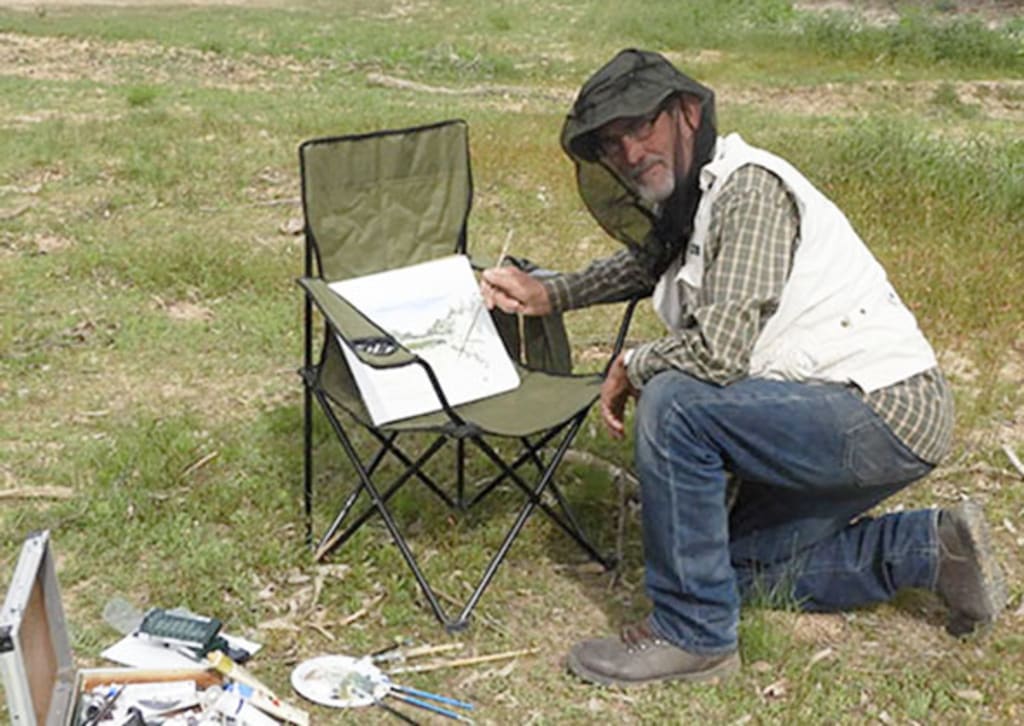
The word Desert conjures ideas and connotations to people; dry, deserted, hot, and empty. I have just returned from a ten-day trip to the Strzelecki desert in South Australia. I was incredibly surprised as it was not what I expected. It rained two weeks ago, so the landscape was green, with wildflowers everywhere. There were frogs in the water holes. It was unusual to see the red center so green. This desert is not dry now.
When we set up at our Base camp number 2, twenty kilometers south of Innamincka on the Strzelecki River, it did seem desolate. Our crew of ten is here to do a biological survey.
For the last ten years, I have been going with the Scientific Expedition Group to isolated areas of South Australia. I feel fortunate to be part of this expedition as it allows me to do my biological science, sketch, and paint the landscape.
As I set up my tent, I noticed chips of worked stone tools in the sand. Aboriginal people have occupied this part of the desert for a long time, and I want to know how they lived in this environment.
It is May now, so the weather is warm during the day and cold at night. In the summer, it is forty-plus degrees during the day, so it is an enjoyable time to be here when it is not too hot. But as the day warms up, trillions of flies come up from the ground, so we all wear fly nets so we can work.
The first day’s job is to set up our ten traplines on different vegetation sites. Site one is on the top of a red dune. We place a small wire mesh fence along the sand ridge, twenty cm high by thirty meters. At five-meter intervals, we dig pits into inert poly pipe tubes, our traps. The theory is that animals walk into the mesh, move along, and fall into the traps—only nine more lines to complete today.
After a long exhausting day, we return to base camp as the sun sets. At sunset, the flies stop being pests so we can eat peacefully. A cold beer, rice, and chicken curry are on the menu. We all chat lively about our day and the new things we experienced, and early to bed for all of us.
The second day starts at five am as the sun rises; a quick coffee and a bowl of cereal before we jump into the trucks to head off to check the traplines to record the catch from the night before, three dragon lizards, two frogs, a fat-tailed Dunnart that was pregnant, and various beetles. We have four more traplines to install today in saltbush country. This is a more challenging area to work in the soil in compacted clay that is hard to dig. My job today is to set up a series of micro pits consisting of small vails of alcohol set at the ground level to capture ants and other insects. I set out six pits at each trapline. I am taking lots of photographs, partly because I want to paint the images. I am amazed at how green this part of the desert is after the recent rain. Flowers are abundant; yellow daisies, purple-flowered grasses, and flowering spinifex cover the sides of the red dunes. I will be drinking 2 liters of water today as it is hotter because I was feeling dehydrated last night. Another day of relentless flies and challenging work as we return to base camp at sunset. It is a later start today as I work with the Botany crew. Our job is to find and collect plant specimens in a 10 m quadrat from each trapline site for the SA Herbarium. I am a scribe and plant press collector with limited Australian Botany knowledge. I enjoy learning about the plants in this desert landscape. Back at camp at noon, so I have free time to paint and draw.
Painting in this environment is exceedingly difficult. I use acrylic paint, and the flies land and stick to the paint. One frustrating hour later, I photograph the scene and retreat to the truck to drive back to camp.
Another chilly early morning start. It has been a week, so it is time to dismantle our traplines and complete the paperwork. Then we pack up the base camp and head back to Innamincka, where we spend the night in a bunkhouse with showers and soft beds. After dinner, we sit around the bunkhouse discussing the two camps’ events. We had the best camp for location and good personnel from the discussions.
Before we leave Innamincka, we take a short trip to see the flooding Coopers creek. All the flood water from Queensland flows into Lake Eyre. It is over four hundred kilometers over the rough Strzelecki tract back to Lyndhurst. With a heavy trailer and numerous road trains, it is slow going, so we arrive at the pub after dark with some other crew members.
I went back to Adelaide the next day. I am fortunate at my age to still go on these expeditions as I see landscapes and animals that other people never get to see.
About the Creator
Andrew Barr
Robert Andrew Barr was born in Canada. He became a Lecturer at the University of British Columbia He now lives in Adelaide, South Australia, and is a landscape painter, illustrator, and self-published writer.





Comments
There are no comments for this story
Be the first to respond and start the conversation.